A simple metric which tells you how hard it is to rank for a keyword does not, to be honest, benefit you a great deal. Putting in the extra time during the keyword research, however, will pay off later when you kick-off the SEO process.
Tackling keywords which are too competitive is a common mistake. Getting a figure showing that the keyword is 67% competitive, does not tell you if your domain is eligible to rank for it.
In this article, we will walk you through the process of evaluating the ranking opportunities for your domain. But before we start, let’s make it clear that this process does not apply to branded keywords, as these have their own rules and factors.
Competitors make a keyword difficult
As SEO relies on three areas – backlinks, on-page, and user behavior – there is no way of treating keyword difficulty analysis differently.
Going through these three segments bit by bit may be time-consuming and, at the end of it, you may find out that the page you wanted to spend all your money on does not have much chance of ranking.
“Even though the difficulty of any given keyword offered by any tool is an estimate, it still provides a useful reference point that you can (and should) use for comparison purposes.
To predict the difficulty of a keyword that’s applicable in your (specific) case, look at the keywords you are already ranking for!How much time did they take to rank? Did you need any additional links or content adjustment?
You can use this historical data in your n=1 study and gain a pretty good understanding about what you can expect.”
— Artem Klimkin, Founder, Linkhero

“Some SEOs say: It’s your competitors that rank your website – not Google. This is because every topic and keyword is just as hard to rank for as your competitors are strong.
Keyword difficulty is a first step for understanding the competitiveness of a keyword.
Next, you will want to review page 1: Is there flexibility in the search results or are the top 10 cemented since months or years? What type of pages are ranking (homepage, inner pages), what kind of content (educational/longform or short). If you are not ranking a similar page type and content, you will have a hard time ranking – despite low difficulty.”
— Viola Eva, SEO Consultant and Founder, Flow SEO

Have you analyzed your links & backlink profile?
“I think it’s critical to look at the competing pages that rank well and examine the types of sites that link to them. I don’t let that completely dictate my strategy as every site is unique, but it does help me understand what types of sites I want to go after to improve rankings and traffic. I like to see what forms of content (audio, video, infographics, interactives, etc) are present on the pages that link to my competitors too as that helps me with discovery.”
— Julie Joyce, Owner of Link Fish Media

One thing you should never overlook when looking to improve your ranking is your backlinks. A backlink is, in essence, a connection which runs from a third party website to your domain and which, when executed correctly, acts as a testimonial / vote of confidence for your site.
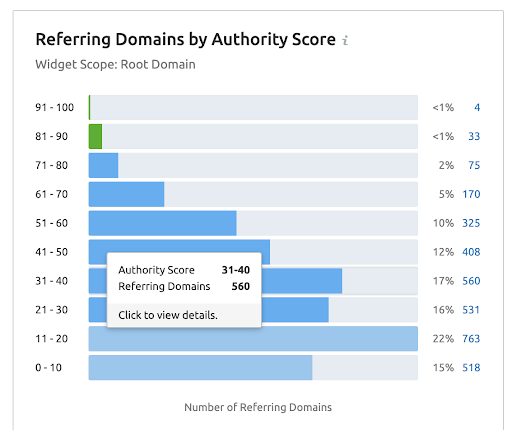
“When analyzing competitors’ backlink profiles it is good to answer this question: Which backlink is stronger for the keyword— one from NYTimes? Or a much smaller, but relevant page that ranks well in the niche?
The strongest backlink you can get is from the page that ranks #1 for your target keyword. Google has already decided it the most relevant and authoritative URL in the world for that keyword.”
— Matt Diggity diggitymarketing.com

Having a backlink from a reputable site serves two purposes – it improves the credibility of your site and, also, can drive new traffic to your site from the third party.
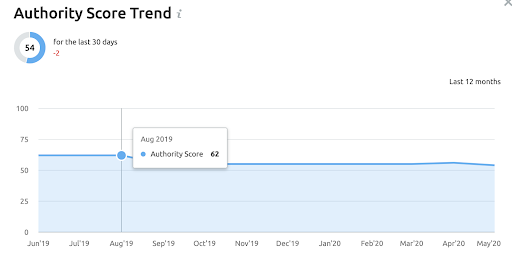
Whilst some backlinks can be valuable, others can actually harm your Google ranking. Bad links, which include spam type links and broken links, might be picked up by Google and the end result could be a Google slap on the wrist in the form of a penalty.
How do I know if I have bad backlinks?
Backlink analysis can help with this. How? Backlink analysis lets you root out bad links – those which are considered spammy or ‘unnatural’.
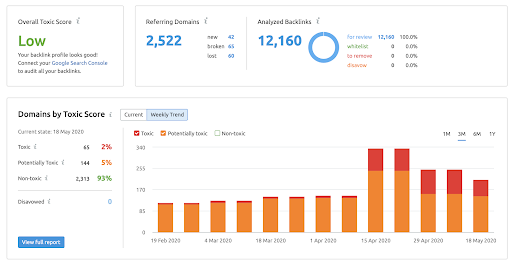
This is important as the gods of Google use your site’s links to evaluate the quality of the site. Basically, the better quality your links, the higher you’ll rank and so, for this reason, it’s a great idea to keep on top of your links to make sure that you’re finding – and getting rid – of the baddies.
Bad links can include those leading to deindexed domains, spammy discussion forums and inefficient private blog networks as well as more sinister kinds of spam. You can also perform backlink analysis on your competitors’ sites to help you figure out what they’re up to in terms of links and then contrast and compare with your own.
Great, but how’s it done?
You can, of course, hire somebody to conduct your backlink analysis for you, however, it won’t cost you an arm and leg to use a tool like SEMrush or Moz Open Site Explorer These are pretty easy to use and are quite affordable. For big guns from the upper shelf look for Link Research Tools also known as LRT.
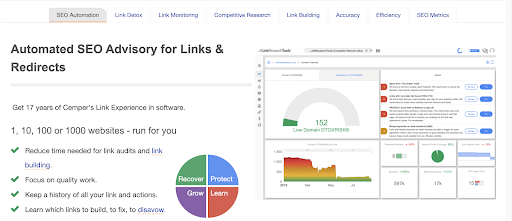
These tools will give you the power to check out your own – and your competitor’s – links in order to analyse the total number of links and unique domains. While you’re at it, it’s a good idea to take a little look at your referring domains too and go much deeper – unique referring IP addresses.
IP What? The ball is in your court.
Ask any serious SEO predator and he will tell you – you may have tons of backlinks, a great number of them coming from the same domains but how many of those domains are sitting at the same IP addresses?
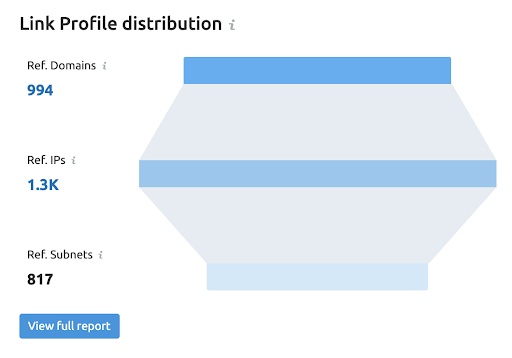
The above screenshot shows the actual number of your unique referring IP addresses also known as referring subnets. The more diversified a number you have, the better your link distribution looks – as long as these subnets deliver high quality domains along with real traffic.
Below is an example of a quick analysis of 44 backlinks coming from 37 domains but all sitting on one IP address.

And last screenshot:
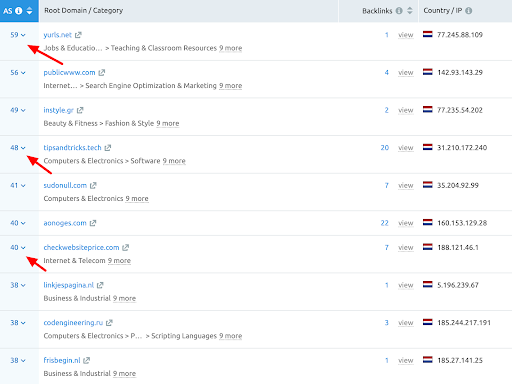
The above screenshot reveals each domain name, category, authority score, IP address, IP country and the number of backlinks. This is something that appears fairly natural for me at the first sight. You agree?
As a professional, it’s a great idea to conduct regular link health checks as these will often be the root of the problem if you’re struggling to rise in the ranks of Google searches.
“We check weekly which sites are linking to us. It helps us understand where our content and solitaire games are getting traction, and if the sites mentioning us are quality ones. It also allows us to be proactive should any poor sites start linking to us. Checking who links to you should be a regular process which can give you great insights.”
— Darshan Somashekar, Founder Solitaired

[Case Study] Improving rankings, organic visits and sales with log files analysis
How many links do you need to rank?
The million dollar question: how many should you build? To start off – look at your competitors. Use more than one software tool to retrieve competitors datas to see what does and doesn’t work for them.
The objective of gaining backlinks is to increase authority and traffic to your site and, so, you’d be forgiven for thinking that it’s a case of the more links the better. In reality, you really should be thinking in terms of quality over quantity – there’s no point in stuffing your website or single URL with tons of links which offer low value.
Depending on the size of your site and the competition in a given niche, sometimes you’re better off aiming for maybe twenty or thirty really good quality links as this will bring you a superior class of visitor – and more of them.
Below is the screenshot of one domain which has managed to build whooping 994 referring domains steadily over the last 6 years. While the authority score is just above average, the end results are pretty excellent if we are talking about their monthly visits.

It’s always a good idea to analyse SERP for a given keyword and get the averages.
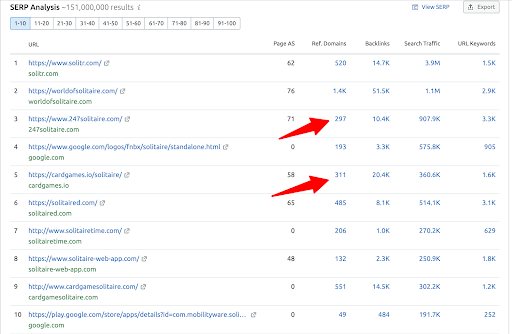
The above results might help you to understand the competition and to also understand the fact that more referring domains is not always the final answer.
Gaining – and maintaining – your links is something that you should be doing continuously. If you stop and switch your strategy around, you may miss the boat when it comes to opportunities.

Not only do you need to focus on getting hold of more great links, you also need to be checking them regularly to make sure that they’re working properly, and that they’re keeping you at the desired position.
When performing any kind of link building, your biggest task is to ensure that you stay on the good side of Google in terms of its rules and guidelines – otherwise, all of your hard work might be wasted one day as we now live in the white hat world of SEO.
“While ‘How many links’ is usually the wrong question since quality and relevance is the key, improving your rankings for a given topic is all about who you compete with and what their metrics are. Although there isn’t a direct correlation between the number of external links and rankings on page 1, in most cases, you do need to be playing the same ballgame with the rest of the results on page 1. So while there are hundreds of ranking factors, knowing how many referring domains each competitor has is an important factor to take into account.
Unfortunately, if page X has 200 referring domains according to a given SEO tool, and Google ignores 100 of them due to low-quality or irrelevance, you will still see 200, and have to dive in and check them for a better understanding of what’s needed in order for you to rank. I personally can’t wait for tools to begin offering more relevant competitive data, from keyword difficulty per domain, to links that actually move the needle.”
— Igal Stolpner, VP Growth, Investing.com

Website content for link-building
A page-level analysis is simply not enough. We can assume that the content that Google serves us in the top ten represents the best results they have. We won’t find any critical information there. Although the length may be your difficulty indicator, let’s be honest, it ain’t really a significant investment to write a longer piece.
We have to dig deeper
The real strength of the URL appears when you check the internal links. The cumulative flow of the authority overpowers the URL, therefore, It is good to know how many pages are boosting the URL and what they are.
I created a simple process for supportive pages analysis which incorporates some advanced clustering algorithms within a bonus step.
We will try to answer this question:
What are the topics that my competitors cover within their domains which help them rank for keyword X?
- Step 1: Determine who your competition is by searching your keyword on Google. Copy the top 10 results and crawl your direct competitors.
- Step 2: Extract pages that are internally linking to the page which ranks for the keyword you target.
- Step 3: Prepare a list of supporting URLs and analyze their visibility with an appropriate tool.
You could stop here and check how many pages that have traffic are internally linking to the article as this will give you an idea of how many valuable internal links you have to build.
But I have a bonus step for the SEO scientists.
- Step 4: Feed the list to the clustering algorithm; there are some pretty slick ways of doing this in python (example).

The clustering algorithm is super helpful here because of its ability to recognize similar pages and then group them.
Here is what you can get out of it:
The more topics found, the more difficult your keyword will be.
Why do more topics make a keyword more difficult?
The answer is simple – it will require more supporting articles from you, not just to have them covered but also to rank them. Relevant pages that are internally linking to you are powerful ranking signals.
If you can hunt them down and determine which ones are the most popular among the competitors – well, you have just created a prioritized content plan as a side effect of the analysis.
Here is an example of clustered topics.
The process can be optimized and automated but, even if it is not – it still doesn’t add up to a huge amount of work. The content plan as a bonus really is worth it.
User intent as a difficulty measurement
It’s time to take care of the user preferences now. There are SERPs with homogenous user intent among the top 10, but these are less and less popular. Google serves mixed intent more often than ever before; they do this to satisfy different types of searchers who look for different results using the same query.
This can be confusing but there is a pretty easy solution; you have to be aware that it may be tricky to change the intent mix in the SERP.
If there are five directories and five local business rankings then, automatically, the keyword becomes more difficult. Tight space in the SERP is often a deal-breaker for a keyword, and it could get worse; Google may serve eight out of ten pages with a different business model than yours.
Prioritize such keywords down, even if they have a top search volume. You could be the 6th local business there but, on the 3rd page of search results due to tight space for pages like yours.
Being aware of this will save a lot of time and money spent on positioning your page for the keyword which may never end up rewarding you.
Measure available space in the top 10 for pages similar to yours. The more open space, the easier it will be to sneak onto the first page.
Conclusion
- 1. Measure your competitors’ strengths and check how many you can outrank.
- 2. Make sure to check available space in the top ten, so you are not fighting for a keyword that has different user intent.
- 3.Add a new column to your keyword research sheet. The ratio of pages that are too strong to pages that you can outrank will help you to find the keywords that are within your reach.
“The power of dedicated supporting content is woefully underestimated by SEOs nowadays. We’ve been told how smart Google is over and over, but the fact of the matter is that often Google still needs very clear signals about specific queries you want to rank for.
When you’re finding you can’t rank well with just the one article, build support content around it in a hub-and-spokes kind of way. You’ll see that the main article will start ranking better as the support content starts ranking.”
— Steven van Vessum, VP of Community at ContentKing

“Think about what problem you’re solving for the user who’s landing on your website. Think about different personas and how you can make them all happy by serving the content they would be looking for. Once you’ve the problem statement in front of you, you’re halfway there with the answer i.e amazing content to keep the user engaged and happy, and that’s the key for success.
Great content and experience will not only make your users happy, but search engines will start to love your website and you’ll be rewarded accordingly through great rankings. Additionally, everyone likes to talk about good products, so ‘organic’ backlinks and mentions are coming your way to further boost your brand.”
— Nitin Manchanda, Global Head of SEO, Omio

“It’s easy to be reliant on tools that provide metrics around difficulty or estimated search volume. But if you are not going to the SERPs to audit the type of pages ranking, and the human-quality of the competing pages, you are going into battle sorely unarmed. The pre-work in developing a campaign is equally as valuable as the execution. Studying the search engine result pages will give you an advantage with on-page SEO, acquiring links, and content strategy.”
— Bill Sebald, Managing Partner at Greenlane

“By failing to prepare, you are preparing to fail. Doing your research before starting any campaign is important. When doing your research it’s not only important to look at what results Google is showing for a keyword, but actually understanding why those results are being shown.
You should consider the demographics of these sites, the format of the content, the age of the content and their authority. Do the landing pages and websites offer the intent you are wanting to compete with? How are they formatted and do they use rich media such as video or use of imagery? How often was this page updated, when was it first published? Has this page ranked there for a long time for this query? Do people link to this page as a high quality resource?
When doing your research it’s important to ask these types of questions first. Then you will have the blueprint of a plan for success.”
— Michael Field, SEO Consultant of MJField

“Show me what they are ranking on and I am not… so GAP Analysis is the way to go. Looking at industry through the ranking of more than one website, looking for “pockets” (topics) where competitors are ranking simultaneously is a strong signal of opportunities to write about. These days plenty of tools like for example SEMRush can quickly generate one. Merging various parts of GAP analysis can also be beneficial to go very deep into the topic we want to cover.”
— Lukasz Zelezny, SEO Consultant, Owner of SEO.London

This article is a collaboration between Milosz and Michal Suski, Co-Founder at Surfer SEO

